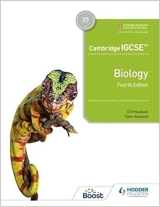Chapter 6. Plant structure and function
Page 54
1. a Epidermis. Helps maintain shape, reduces evaporation, resists entry of bacteria and fungi.
b Mesophyll. Photosynthesis.
2. No chloroplasts are present.
3. a Oxygen and water vapour.
b Carbon dioxide.
4. Grasses and plants such as daffodil, iris. (See Fig 30.20 on p. 278).
5. Closure of the stomata prevents excessive loss of water but has the disadvantage that it also prevents intake of carbon dioxide for photosynthesis.
Page 56
1. Vessels (xylem), sieve tubes (phloem), fibres.
2. The vascular bundles, particularly the vessels and lignified cells. The epidermis helps to maintain shape. (See Experiment 2 on p. 58).
3. Xylem consists of vessels. Lignified tubes formed from dead cells joined end to end. Phloem consists of living cells, also joined end to end but with a continuity of living cytoplasm. They are not lignified. The function of xylem is to conduct water from roots to leaves. The function of phloem is to conduct food. The direction depends on the needs of the plant.
Page 57
1. Xylem conducts water and mineral ions from the roots to the rest of the plant.
Palisade cells make glucose by photosynthesis.
The root hair absorbs water and minerals from the soil.
The root cap protects the growing point of the root from damage as it grows through the soil.
A stoma controls the passage of water vapour from the leaf to the atmosphere. It also allows the passage of carbon dioxide and oxygen into or out of the leaf.
The epidermis helps maintain the shape of the leaf or stem, reduces evaporation and protects the inner tissues from bacteria and fungi.
2. A stem is likely to be green and to have buds. A root will be white with no buds but, possibly, lateral roots.
With the aid of a hand lens or microscope you would be able to see that the stem’s vascular bundles were in a circle just beneath the epidermis. The root’s vascular bundle would be in the centre.
3. a Stoma, air space, mesophyll cell.
b Root hair cell, xylem vessel, midrib, leaf ‘vein’. mesophyll cell.
4. It root hairs appeared on the part of the root that was growing, (extending), they would be rubbed off as the root pushed through the soil.
5. A petal is a living structure and needs a supply of water, mineral ions and food, so you would expect vascular bundles to be present. |
Downloads
Download the answers in PDF format below
Section 1, Chapters 1-5
Section 2, Chapters 6-9
Section 3, Chapters 10-12
Section 3, Chapters 13-17
Section 3, Chapters 18-20
Section 4, Chapters 21-24
Section 5, Chapters 25-27
Section 5, Chapters 28-29
Section 6, Chapters 30-34
Section 6, Chapters 35-37
Section 7, Chapters 38-39
Section 8, Chapters 40-41
|
